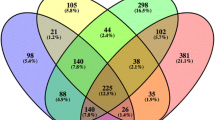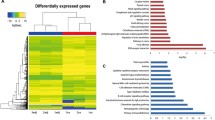Abstract
This study aims to explore key prognostic and diagnostic biomarkers involved in the pathogenesis of papillary thyroid cancer (PTC) which is one of the most common endocrine cancers and whose occurrence is rapidly increasing. Papillary thyroid cancer datasets containing normal and tumor samples were collected from Gene Expression Omnibus. Protein–protein interaction (PPI) network for common upregulated differentially expressed genes (DEGs) was constructed, and hub genes were studied. Gene ontology and Kyoto Encyclopedia of Genes and Genomes pathway enrichment analysis were performed to identify the vital biological behaviors and pathways involved in PTC. PPI network analysis demonstrated the interaction between 134 common upregulated DEGs, and top 15 pivotal genes with highest degree of connectivity were retrieved. Three of the hub genes (DPP4, ITGA2, FN1) were linked to the prognosis of PTC patients and considered clinically relevant core genes via survival analysis. We suggest that the identification of key genes associated with PTC development help us in understanding molecular mechanisms related to disease. These genes could also be considered the diagnostic biomarkers or as therapeutic targets in the future treatment for PTC.












Similar content being viewed by others
Data Availability
The datasets generated during and/or analyzed during the current study are available in the Gene Omnibus (GEO) repository.
References
Aratake, Y., Kotani, T., Tamura, K., Araki, Y., Kuribayashi, T., Konoe, K., & Ohtaki, S. (1991). Dipeptidyl aminopeptidase IV staining of cytologic preparations to distinguish benign from malignant thyroid diseases. American Journal of Clinical Pathology, 96(3), 306–310. https://doi.org/10.1093/AJCP/96.3.306
Axelsen, J. B., Lotem, J., Sachs, L., & Domany, E. (2007). Genes overexpressed in different human solid cancers exhibit different tissue-specific expression profiles. Proceedings of the National Academy of Sciences of the United States of America, 104(32), 13122. https://doi.org/10.1073/PNAS.0705824104
Broustas, C. G., & Lieberman, H. B. (2014). DNA damage response genes and the development of cancer metastasis. Radiation Research, 181(2), 111. https://doi.org/10.1667/RR13515.1
Chernaya, G., Mikhno, N., Khabalova, T., Svyatchenko, S., Mostovich, L., Shevchenko, S., & Gulyaeva, L. (2018). The expression profile of integrin receptors and osteopontin in thyroid malignancies varies depending on the tumor progression rate and presence of BRAF V600E mutation. Surgical Oncology, 27(4), 702–708. https://doi.org/10.1016/J.SURONC.2018.09.007
Chin, C. H., Chen, S. H., Wu, H. H., Ho, C. W., Ko, M. T., & Lin, C. Y. (2014). cytoHubba: Identifying hub objects and sub-networks from complex interactome. BMC Systems Biology, 8(4), 1–7. https://doi.org/10.1186/1752-0509-8-S4-S11/TABLES/4
Cooper, C. S., Campbell, C., & Jhavar, S. (2007). Mechanisms of disease: biomarkers and molecular targets from microarray gene expression studies in prostate cancer. Nature Clinical Practice Urology, 4(12), 677–687. https://doi.org/10.1038/ncpuro0946
de Micco, C., Savchenko, V., Giorgi, R., Sebag, F., & Henry, J. F. (2008). Utility of malignancy markers in fine-needle aspiration cytology of thyroid nodules: comparison of Hector Battifora mesothelial antigen-1, thyroid peroxidase and dipeptidyl aminopeptidase IV. British Journal of Cancer, 98(4), 818–823. https://doi.org/10.1038/sj.bjc.6604194
Grant, C. S. (2014). Papillary thyroid cancer: Strategies for optimal individualized surgical management. Clinical Therapeutics, 36(7), 1117–1126. https://doi.org/10.1016/J.CLINTHERA.2014.03.016
Greco, A., Miranda, C., & Pierotti, M. A. (2010). Rearrangements of NTRK1 gene in papillary thyroid carcinoma. Molecular and Cellular Endocrinology, 321(1), 44–49. https://doi.org/10.1016/J.MCE.2009.10.009
Jayanthi, V. S. P. K. S. A., Das, A. B., & Saxena, U. (2020). Grade-specific diagnostic and prognostic biomarkers in breast cancer. Genomics, 112(1), 388–396. https://doi.org/10.1016/j.ygeno.2019.03.001
Lee, J. J., Wang, T. Y., Liu, C. L., Chien, M. N., Chen, M. J., Hsu, Y. C., Leung, C. H., & Cheng, S. P. (2017). Dipeptidyl peptidase IV as a prognostic marker and therapeutic target in papillary thyroid carcinoma. The Journal of Clinical Endocrinology & Metabolism, 102(8), 2930–2940. https://doi.org/10.1210/JC.2017-00346
Li, X., He, J., Zhou, M., Cao, Y., Jin, Y., & Zou, Q. (2019). Identification and validation of core genes involved in the development of papillary thyroid carcinoma via bioinformatics analysis. International Journal of Genomics, 2019:5894926. https://doi.org/10.1155/2019/5894926
Prescott, J. D., & Zeiger, M. A. (2015). The RET oncogene in papillary thyroid carcinoma. Cancer, 121(13), 2137–2146. https://doi.org/10.1002/CNCR.29044
Shannon, P., Markiel, A., Ozier, O., Baliga, N. S., Wang, J. T., Ramage, D., Amin, N., Schwikowski, B., & Ideker, T. (2003). Cytoscape: A software environment for integrated models of biomolecular interaction networks. Genome Research, 13(11), 2498–2504. https://doi.org/10.1101/GR.1239303
Shen, Y., Dong, S., Liu, J., Zhang, L., Zhang, J., Zhou, H., & Dong, W. (2020a). Identification of potential biomarkers for thyroid cancer using bioinformatics strategy: a study based on GEO datasets. BioMed Research International, 2020:9710421.https://doi.org/10.1155/2020/9710421
Soares, P., Trovisco, V., Rocha, A. S., Lima, J., Castro, P., Preto, A., Máximo, V., Botelho, T., Seruca, R., & Sobrinho-Simões, M. (2003). BRAF mutations and RET/PTC rearrangements are alternative events in the etiopathogenesis of PTC. Oncogene, 22(29), 4578–4580. https://doi.org/10.1038/sj.onc.1206706
Song, G., Liu, K., Yang, X., Mu, B., Yang, J., He, L., Hu, X., Li, Q., Zhao, Y., Cai, X., & Feng, G. (2017). SATB1 plays an oncogenic role in esophageal cancer by up-regulation of FN1 and PDGFRB. Oncotarget, 8(11), 17771. https://doi.org/10.18632/ONCOTARGET.14849
Tang, Z., Kang, B., Li, C., Chen, T., & Zhang, Z. (2019). GEPIA2: An enhanced web server for large-scale expression profiling and interactive analysis. Nucleic Acids Research, 47(W1), W556–W560. https://doi.org/10.1093/NAR/GKZ430
Taye, B., Vaz, C., Tanavde, V., Kuznetsov, V. A., Eisenhaber, F., Sugrue, R. J., & Maurer-Stroh, S. (2017). Benchmarking selected computational gene network growing tools in context of virus-host interactions. Scientific Reports, 7(1):5805. https://doi.org/10.1038/S41598-017-06020-6
Yang, Z., Yuan, Z., Fan, Y., Deng, X., & Zheng, Q. (2013). Integrated analyses of microRNA and mRNA expression profiles in aggressive papillary thyroid carcinoma. Molecular Medicine Reports, 8(5), 1353–1358. https://doi.org/10.3892/MMR.2013.1699/HTML
Zhou, Y., Shu, C., & Huang, Y. (2019). Fibronectin promotes cervical cancer tumorigenesis through activating FAK signaling pathway. Journal of Cellular Biochemistry, 120(7), 10988–10997. https://doi.org/10.1002/JCB.28282
Acknowledgements
We thank National Institute of Technology Warangal for providing the computational facility.
Funding
Not applicable.
Author information
Authors and Affiliations
Contributions
All authors contributed to the study conception and design. Data collection and analysis were performed by Ritu Bansal with the help of Urmila Saxena. The first draft of the manuscript was written by Ritu Bansal and Urmila Saxena read and approved the final manuscript.
Corresponding author
Ethics declarations
Ethical Approval
Not applicable.
Consent to Participate
Not applicable.
Consent to Publish
Not applicable.
Competing Interests
The authors declare no competing interests.
Additional information
Publisher's Note
Springer Nature remains neutral with regard to jurisdictional claims in published maps and institutional affiliations.
Rights and permissions
Springer Nature or its licensor (e.g. a society or other partner) holds exclusive rights to this article under a publishing agreement with the author(s) or other rightsholder(s); author self-archiving of the accepted manuscript version of this article is solely governed by the terms of such publishing agreement and applicable law.
About this article
Cite this article
Bansal, R., Saxena, U. Integrative Analysis of Potential Biomarkers Involved in the Progression of Papillary Thyroid Cancer. Appl Biochem Biotechnol 195, 2917–2932 (2023). https://doi.org/10.1007/s12010-022-04244-5
Accepted:
Published:
Issue Date:
DOI: https://doi.org/10.1007/s12010-022-04244-5




